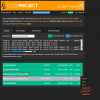Below is Chat GPT answer.
To sum it up 6.2 used PT models and .NET uses ONNX models. The .NET module also works with Nvidia, AMD, and Intel GPUs and is faster. For my RTX 3090 using 6.2 it only does about 17ms and .NET does about 5ms
PT (PyTorch) and ONNX (Open Neural Network Exchange) are both frameworks used in the field of deep learning, but they serve different purposes and have different characteristics. Here are the key differences between PT and ONNX:
- Framework Purpose:
- PyTorch (PT): PyTorch is a popular deep learning framework that provides a flexible and dynamic computational graph. It is widely used for building and training neural networks, conducting research, and prototyping models. PyTorch allows for easy experimentation and provides a range of tools for training and deploying models.
- ONNX: ONNX, on the other hand, is not a deep learning framework itself but an open standard for representing trained models. ONNX serves as an intermediate format that enables interoperability between various deep learning frameworks, including PyTorch, TensorFlow, Caffe, and more. It allows models to be trained in one framework and then transferred to another for inference or deployment.
- Computational Graph Representation:
- PyTorch (PT): PyTorch uses a dynamic computational graph, meaning that the graph is constructed on-the-fly during the execution of the code. This dynamic nature allows for greater flexibility in model construction, making it easier to implement complex architectures and dynamic operations.
- ONNX: ONNX, on the other hand, uses a static computational graph. The graph is defined and optimized before runtime, allowing for efficient execution across different frameworks. ONNX provides a standardized representation that captures the structure of the model and the operations it performs.
- Model Portability and Interoperability:
- PyTorch (PT): PyTorch models are primarily used within the PyTorch ecosystem. While PyTorch provides mechanisms for saving and loading models, the models are not directly portable to other deep learning frameworks without conversion.
- ONNX: ONNX provides a standardized format for representing models, enabling interoperability between different deep learning frameworks. Models trained in PyTorch can be converted to the ONNX format and then loaded into other frameworks such as TensorFlow for inference or deployment. This portability is especially useful in production environments where different frameworks may be used for different stages of the workflow.
- Runtime Efficiency:
- PyTorch (PT): PyTorch is known for its efficient execution during the training phase. It leverages dynamic graphs and provides extensive GPU support, allowing for high-performance computations on parallel hardware.
- ONNX: ONNX is designed for efficient runtime execution. The static computational graph used by ONNX allows for optimizations and backend-specific performance improvements. ONNX models can be optimized for specific hardware platforms, leading to faster inference times.
In summary, PyTorch (PT) is a deep learning framework for model development and training, while ONNX (Open Neural Network Exchange) is an open standard for model representation, enabling interoperability between different deep learning frameworks. PT provides flexibility and dynamic graphs,
while ONNX offers model portability and efficient runtime execution.




